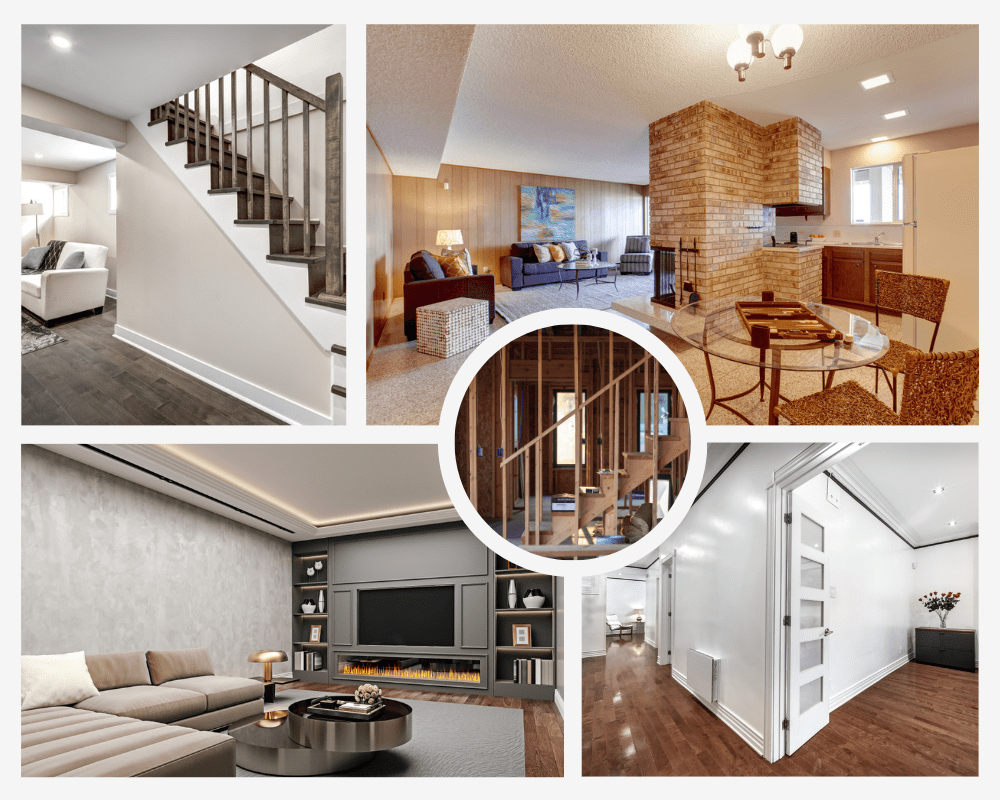Thinking about a basement conversion?
Some basements are unloved dumping grounds for holiday decor, or hideous dark dungeons collecting dust and spider webs. Rather than letting your basement go to waste, why not use it to boost the value of your home? There are plenty of ways to convert a basement so that it becomes a functional space used for entertaining, or as an additional bedroom for a growing family. If a basement conversion is on your list of home improvement projects, then feel free to read or skim through a few tip and ideas that we have listed.

Basement Conversion Permits & Planning
Before you start planning your basement remodel, it’s important to check with your city’s zoning and building codes. This will ensure that you’re not breaking any laws and are following the proper regulations. For instance, the city might request that you have windows in your basement apartment to avoid fire spreading from your property to nearby properties, or if you are planning to rent your finished basement, they may have a minimum requirements for escape routes and soundproofing.
Also, if your home is part of a HOA, there may be restrictions in the bylaws that need to considered before putting together a design layout. Mitigating problems with your city and neighbors will help prevent delays and cost overruns. An experienced general construction contractor will expect and be happy to help you navigate through this part of the project. Ask everything you need to know so that you feel completely comfortable with moving forward.


Basement Conversion Layout
If you want to convert your basement, you need to plan out your layout. This will help you make sure that the basement can be safely lived in or used. It will also help you design a layout that works with your existing home and neighborhood.
Basement apartments are often smaller than their traditional counterparts. The ceilings are lower and you won’t always have as much space for furniture and accessories. They also tend to have less natural light than apartments with a lot of windows.
Luckily, there are plenty of options when it comes to designing your finished basement. You can choose to include things like a laundry room or a designated kitchen with a refrigerator and stovetop.
You should also consider creating a separate exterior entrance as part of your basement remodeling project for safety purposes and convenience. This will help you avoid any liability issues should you choose to rent it out.
In addition, you should consider adding a bathroom and kitchenette, so that your basement can have its own without having to share. These features will allow your renters to enjoy a comfortable living environment and save you money on utilities.
When converting your basement into an apartment, you should hire a professional to handle the necessary plumbing, electrical and insulation work. They can also assist with drywall installation and other finishing touches.
Once you’ve completed the conversion, you should thoroughly inspect to make sure everything is working properly. This includes checking for leaks, faulty wiring and water damage. You should also perform a test for carbon monoxide and other hazards.
Finishing your basement is a great way to add extra space in your home and increase its value. However, it can be challenging to create an apartment that meets all the regulations.
Basement Conversion Aesthetics
Converting a basement to an apartment is a great way to add extra living space to your home. Not only can it make your home more livable, but it can also add a lot of value to your property.
Whether you’re planning to rent out the space or use it for your own personal needs, there are several aesthetic elements that you should consider before you start construction. These include paint, flooring, lighting and decor.
Choose a color that will brighten the space without overpowering it. Dark colors will make a basement feel more dingy, while light shades will brighten the area and make it look larger.
You can also use a neutral hue for your walls, which will go well with any natural light that enters the room. However, if you do want to add some pops of color, consider using a bold paint for one accent wall.
To make your basement bedroom feel less like a dungeon, hang compact ceiling lights and supplement with additional recessed lighting. Plus, if you have tile or hardwood floors in the room, invest in a plush area rug to soften the floor.
Another option is to install custom-sized blinds or a window treatment that can be opened to let in sunlight. If you’re not sure what type of window treatment will best suit your space, consult a professional.
Regardless of what you decide to do, you should remember that basements are subterranean spaces that can be difficult to decorate. But with a little ingenuity, you can turn a basement into a beautiful and comfortable space that your family will enjoy for years to come.
Aesthetic elements that can help make a basement apartment more attractive to potential tenants include modern design, statement light fixtures and unique wall art. These features can help your basement apartment stand out from the crowd and create a place that will be both welcoming and functional for your tenants.
Ultimately, converting your basement to an apartment will contribute value to your home and provide a valuable income opportunity. But you should take your time when making these changes to ensure that you’re doing it right and that the finished product will be a space that your potential renters can enjoy for years to come.
Basement Conversion Amenities
If you’re a homeowner with a basement and are considering turning it into an apartment, there are many amenities that you can incorporate to make the space livable. These amenities can be anything from a kitchen, bathroom, or living room.
The amenities that you can add to a basement apartment are varied and depend on your budget, local zoning laws, and your personal preferences. You’ll want to consult with local officials to ensure that you won’t run into any issues when converting your basement to an apartment, and to find out if they have any rules against multi-family occupancy.
There are also many different types of lighting and flooring you can use to create the perfect atmosphere for your apartment. You can use cool colors to make the room appear brighter, or you can install large windows that reflect any natural light.
Another important thing to consider is privacy. You’ll need to build a separate entrance for your apartment, and you may want to add extra insulation to prevent sound from traveling up to the other floors.
In addition, you’ll want to include a lot of storage space in your basement apartment. You can use this to store things like clothing, furniture, and appliances.
Another good idea to think about is soundproofing the ceiling and walls in your basement, so you can have peace and quiet at all times. This will help you keep the noise levels down and ensure that you and your family can sleep peacefully at night.
You can even install heating and cooling systems in your basement apartment to ensure you have comfortable temperatures throughout the year. These systems are usually a good investment, as they will help you save money on heating and cooling costs.
A basement can be a great way to accommodate a large family with limited space. By converting your basement into an apartment, you’ll be able to provide more livable space for your family members, while adding value to your home. In addition, you’ll have the opportunity to earn an income with your newly remodeled basement apartment.





 MANHATTAN
250 Park Avenue
MANHATTAN
250 Park Avenue LONG ISLAND
100 Duffy Ave
LONG ISLAND
100 Duffy Ave WESTCHESTER COUNTY
73 Market Street
WESTCHESTER COUNTY
73 Market Street FAIRFIELD COUNTY
1000 Lafayette Blvd
FAIRFIELD COUNTY
1000 Lafayette Blvd